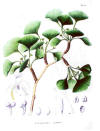|
GINKGO BILOBA
FOR SCI & MS |
|
|
|
|

GINKGO BILOBA
Obtained from the leaves of a deciduous tree
originally from China, Ginkgo biloba is one of mankind’s most
ancient medicines. Fossil records indicate that the tree has been around
for over 200-million years, and some of the long-living ginkgos at
Chinese temples are more than 1,500-years old. Given ginkgos are highly
disease and insect resistant and grow in urban environments where other
trees can not, it is not surprising that they possess substances with
medicinal properties.

In Europe, ginkgo is the most widely sold and
prescribed phytomedicine; in the U.S., it is one of the top ten
best-selling herbal remedies. Supported by varying degrees of animal
research and clinical studies, ginkgo may provide benefits for a variety
of disorders, including:
 | Cerebral vascular insufficiency and impaired
mental performance (e.g., senility); |
 | Alzheimer’s disease (AD); |
 | Cochlear deafness; |
 | Senile macular degeneration; |
 | Peripheral arterial insufficiency; |
 | Erectile dysfunction; |
 | Depression and anxiety; |
 | Multiple sclerosis (MS); |
 | Traumatic brain injury; |
 | SCI. |
Ginkgo operates through physiological mechanisms
especially relevant for neuronal health. For example, it is an
antioxidant, maintains cell-membrane integrity, enhances oxygen use and
metabolism, augments neurotransmission, and inhibits a form of
programmed cell death called apoptosis.
SPINAL CORD INJURY
Using a rat model of acute injury, Turkish
investigators showed that ginkgo extract inhibits post-injury lipid
peroxidation, a biochemical process that mediates damage to the injured
cord. Ginkgo’s inhibition was even greater than methylprednisolone, a
glucocorticoid-steroid drug routinely administered after injury to
minimize neurological damage (Koc et al. Res Exp Med 195, 1995).
More recently, Chinese investigators demonstrated
that ginkgo extract is neuroprotective in rats with experimental SCI (Ao
et al. Spinal Cord, 44, 2006). Specifically, after cutting the
spinal cord in half at the thoracic T-9 level, rats were given either
ginkgo or saline. The ginkgo-treated rats had smaller injury-related
cavities, less conduction-inhibiting demyelination (i.e., loss of
insulating myelin coat surrounding neurons), and less apoptotic neuronal
cell death.
MULTIPLE SCLEROSIS
 | Dr. SK Johnson and colleagues (Charlotte, NC)
noted that consuming ginkgo generated modest improvements with
respect to MS-related fatigue, symptom severity, and functional
performance (Explore 2(1), 2006.). |
 | Dr. Jesus Lovera et al (Portland, OR) observed
that subjects who received 12 weeks of ginkgo had improvement in an
evaluation parameter associated with information processing,
concentration, attention, mental flexibility, and ability to ward
off distractions (Mult Scler. 13, 2007). |
TOP |
| |
| |
|
| |
| |
|
| |
| |
|
|